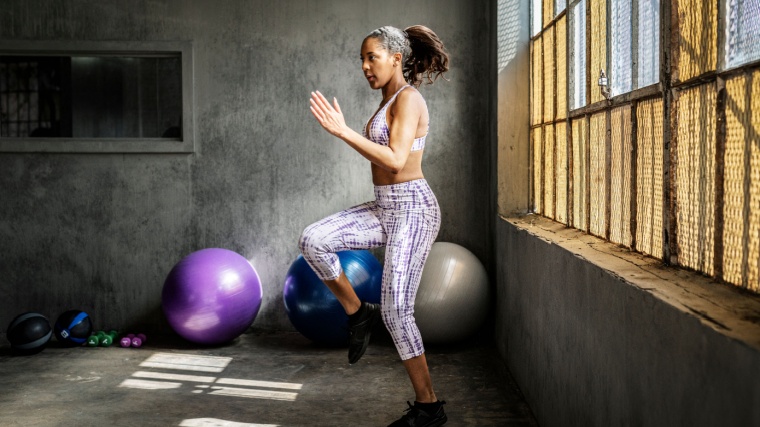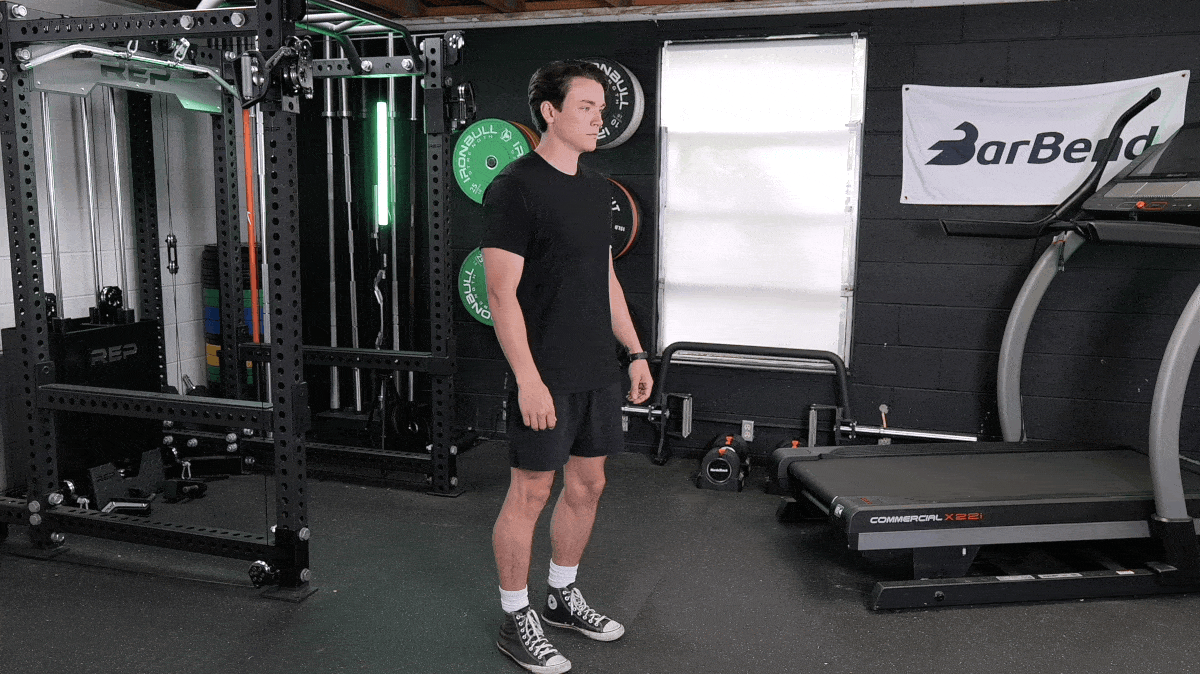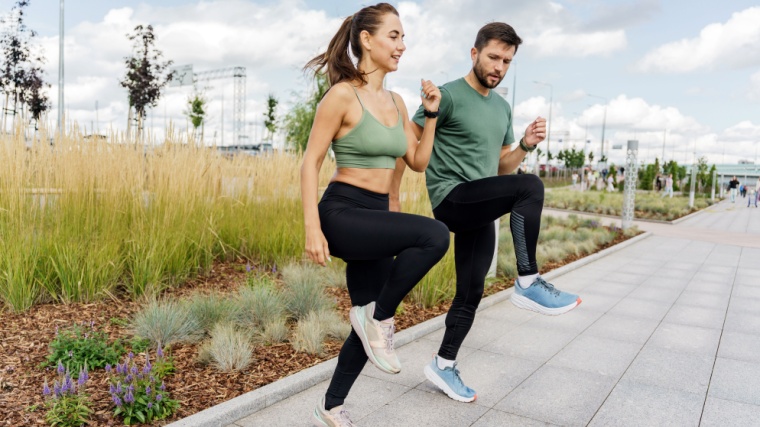Calisthenics training is a massively underrated category of exercise. Not only are these bodyweight exercises helpful in nearly every workout program, but they typically don’t require set-up, tear-down, or equipment to get started.

And it’s not all about push-ups and burpees, either. High knees are the perfect blend of lower body warm-up exercise, introductory plyometrics, and even have cardio circuit potential — yes, I’m talking low-impact high-intensity interval training. Here’s what you need to know about high knees and how to take your home workout to the next level.
How to Do High Knees
High knees require no equipment — just a little coordination. The goal is to spring between the ball of each foot, flexing your knees and hips on the working side to draw one knee as high as possible.

[Read More: The Best Leg Exercises for Your Next Leg Day]
- Step 1 — Place your feet hip-width apart and brace your full body. Maintain soft knees and slowly shift towards the balls of your feet.
- Step 2 — Actively extend your left hip and knee, flexing the glute and quad on that side.
- Step 3 — Explosively flex your right hip and knee, drawing your upper leg to at least 90 degrees of flexion using your hip flexors.
- Step 4 — Drive your right leg back down, actively extending your hips and knees using your glutes and quads. Simultaneously shift your weight to your right leg and repeat the process using your left leg.
Sets and Reps
High knees are not like your typical resistance training exercise, or even many calisthenics. High knees are meant to be performed rapidly and plyometric-like springiness to your steps and quick transitions between each leg. This means you’re not programming like you would for hypertrophy or strength; but rather, aiming for higher repetitions or timed sets.
Modifications
- Make it Easier: Slow it down! If you’re struggling with the coordination needed for high knees, try intentionally pausing with one leg extended and one leg flexed to really work on the technique.
- Make it Harder: Try standardizing your high knee height. Place your arms at your sides and raise your forearms to make a 90 degree “L-shape” above your thighs. Wrap a band around your arms to create a high knee target to aim for each repetition.
High Knees Variations
High knees are a quick and easy exercise to start working into your training, but even relatively bare-bones bodyweight exercises have plenty of variation. Paused high knees, reverse-lunge into a high-knee, and alternating jump lunges are great choices here.
- Paused High-Knee: Perform the high knee as normal but without the explosive transitions between sides. Fully extend one leg and flex the other, holding that position for a full second.
- Reverse-Lunge into High-Knee: The high knee is a great second leg of the reverse lunge exercise. Step back into a reverse lunge, and while you return to the starting position, drive your non-working leg up into a high knee to finish the rep.
- Alternating Jump Lunge: Perform a reverse lunge and pause in the down position. Jump by driving with both legs and alternate your front and back legs into the opposite position.
High Knees Alternatives
You’re able to snag a similar set of benefits as your high knees using alternative exercises that suit your needs, goals, or preferences. The sprinter-pose, step-up, and low-box toe-taps all work as great swaps for your high knees.
Sprinter Pose
- Drive your left leg down into the ground, extending your hip and knee by squeezing the glutes and quads into a static hold.
- Flex your right leg by drawing your thigh to about 90 degrees using your hip flexors.
- Hold this position for a brief moment, maintaining full body tension and bracing.
Step-Up

- Place one foot on a medium-height box. Lean slightly forward over the leg performing a subtle hinge to brace your body.
- Establish full-body tension and drive through the full foot that is on the box. Extend your hip and knee by flexing your glute and quad on the working side.
- Lock out by standing tall and stepping back down to reverse course. Alternate repetitions or complete the set on one side entirely before matching it on the opposite leg.
Low-Box Toe-Tap
- Place a low box in front of you — about six inches of height is great for many people.
- Shift your weight towards your left side, raising your right foot and lightly tapping the top of the box with the ball of your foot.
- Place your right foot back on the ground, transitioning your body weight to the right leg, and repeat the motion with your left foot.
- Pick up the pace! Begin increasing the speed of each repetition as you gain confidence in your coordination.
Muscles Worked by High Knees
There are many muscles at play during high knees which is what makes them such a killer. The quadriceps, hip flexors, glutes, and core are all major players here.
- Quadriceps: Your quadriceps are responsible for extending your knee and helping flex your hip. They are essential for stabilizing your stance leg while helping to lift your working leg.
- Hip Flexors: While the quads are powerful hip flexors, they aren’t the only ones. The hip flexor complex (for example, the iliopsoas and rectus femoris) helps pull your thigh into the top of the high knee position.
- Glutes: Your glutes are a massive muscle that help to stabilize your leg on the stance side. The leg that stays planted on the ground uses your glute to lock the hip in full extension and support your posture.
- Core: Your core muscles are essential to your high knees. Maintaining a full-body brace especially through your trunk keeps you from losing balance during rapid transitions between legs.
Benefits of High Knees
The high knees exercise adds a ton of value to any workout, primarily because they are easy to learn and come with a ton of benefits. They help improve your coordination, provide a quick and dirty session of cardio, introduce you to plyometric training, and make for a fantastic warm-up.
They Improve Coordination
The high knees exercise is undoubtedly a coordination challenge as you’re starting out. Between bending your right knee, extending your left knee, managing your hips and core…there’s a lot going on. With that in mind, it quickly becomes second nature, building confidence and quicker transitions between sides. Although it focuses on the lower body, there’s a ton of total body coordination to be had.
Yes, It Can Be a Cardio Exercise — With Low Joint Impact
Calisthenics or resistance training circuits are extremely popular ways of hybridizing your training. Using full body movements such as lunges, squats, or jumping jacks in a quick string of exercises with minimal rest is sure to create a great cardio workout. While not necessarily a cardio exercise specifically, high knees certainly can fit the bill here, as well.
[Read More: The Best Agility Training Exercises for Strength Athletes]
And they’ll do it without banging around on your joints. You can go both fast and gently when you get coordinated enough. That will be a huge benefit both to your joints and to any downstairs neighbors you might have who don’t want to hear your burpee, jumping jack, and mountain climber sessions.
They’re Plyometric
Plyometrics are the style of exercise that draws upon some of the more springy parts of your body. Tendons are a key part of being explosive as your muscles try to move you as quickly as possible.

[Read More: The Best Hypertrophy Leg Workout (+Tips and Tricks)]
Movements like the high knees exercise double down, requiring you to move rapidly but also loading into some of your “springs” in a lower impact, introductory way. It’s accessible to beginners while serving as a springboard — literally — for more explosive movements.
They’re a Solid Warm-Up
Warming up is a crucial part of any training session. High knees make for a great warm-up tool because they hit your full body, get your heart rate up, and are easy to combine with other beneficial movements. Try combining your high knees exercise with butt kicks, performing 10 high knees per leg and then 20 total butt kicks. Your heart rate will be up and your muscles warm in no time.
Common High Knee Mistakes
High knees are a quick and easy movement to integrate into your training, but there are some key points that often go awry. It’s possible to get your knees too high, not high enough, or start to rotate more than you’d want.
Too High
Although the name is quite literally “high knees,” you don’t necessarily want to escape a specific range of motion. Your goal is to use your quadriceps, glutes, and hip flexors to manipulate your position. If you’re not controlled, you might find yourself leaving your range of motion and starting to hyperextend certain positions.
[Read More: The Best Mobility Exercises, PT-Approved]
If you find your knees getting so high that you arch into your back, you’ve gone too far. Revisit your technique and make sure you have a solid core brace.
Not High Enough
Limiting your range of motion is a great way to introduce the high knees exercise and gain confidence in your coordination. However, as you start to pick up steam and perform it at full pace, make sure you’re being consistent with your knee height. Most of the benefits of performing the high knees exercise period come from hitting that specific knee high with rapid transitions.
[Read More: The Best Lower Body Exercises to Level-Up Your Leg Day]
If you’re noticing a slow drop off in your knee height, take a brief rest to recover so that the quality remains as high as your knees should go!
Rotation
High knees are meant to primarily move your leg front to back. Depending on your limb length or body type, you may absolutely experience some rotation (where your legs angle slightly outward). That’s OK. But if it starts to get very noticeable or increase over the set, you might need to take a break. A lot of rotation occurs once your hip flexors start to fatigue. Take a break, shake it out, and come back fresh.
Frequently Asked Questions
High knees are an extremely beneficial and easy-to-apply exercise. Here are some frequently asked questions to better understand the movement.
What are high knees good for?
High knees are great for a number of reasons. They help introduce you to plyometrics or more springy style of exercise, improve coordination, are a fun and effective warm-up, and even integrate well into cardiovascular circuit training.
How many high knees should I do a day?
High knees are an exercise that work well with high frequency and repetition counts. Like all exercises, your muscle groups require time to recover so giving yourself a break between days with high knees is a good idea.
Perform sets of high knees in a higher repetition range (think 15 to 20 total strides to start), or perform them for a timed set such as 30 seconds. Two to four sets of high knees worked into a warm-up is a good way to start.
Can high knees lose belly fat?
Losing belly fat is a long game of managing your daily activity and nutrition, and high knees are certainly a beneficial component of your workouts. With that in mind, high knees are not the main option to really focus on belly fat or weight loss generally, as they work best as a warm-up or as a complimentary exercise rather than a main event.
Are high knees a good ab workout?
High knees absolutely call upon your abs as a part of a good core brace and as part of flexing your hip and rapidly drawing your leg up. However, there are a ton of big muscles like your quads or other hip flexors helping, so the amount of direct work your abs do is a bit offset.
The abs are absolutely involved, but if you’re interested in training your abs, consider more direct work like those found in our best ab exercises guide.
Featured Image: Rawpixel.com / Shutterstock